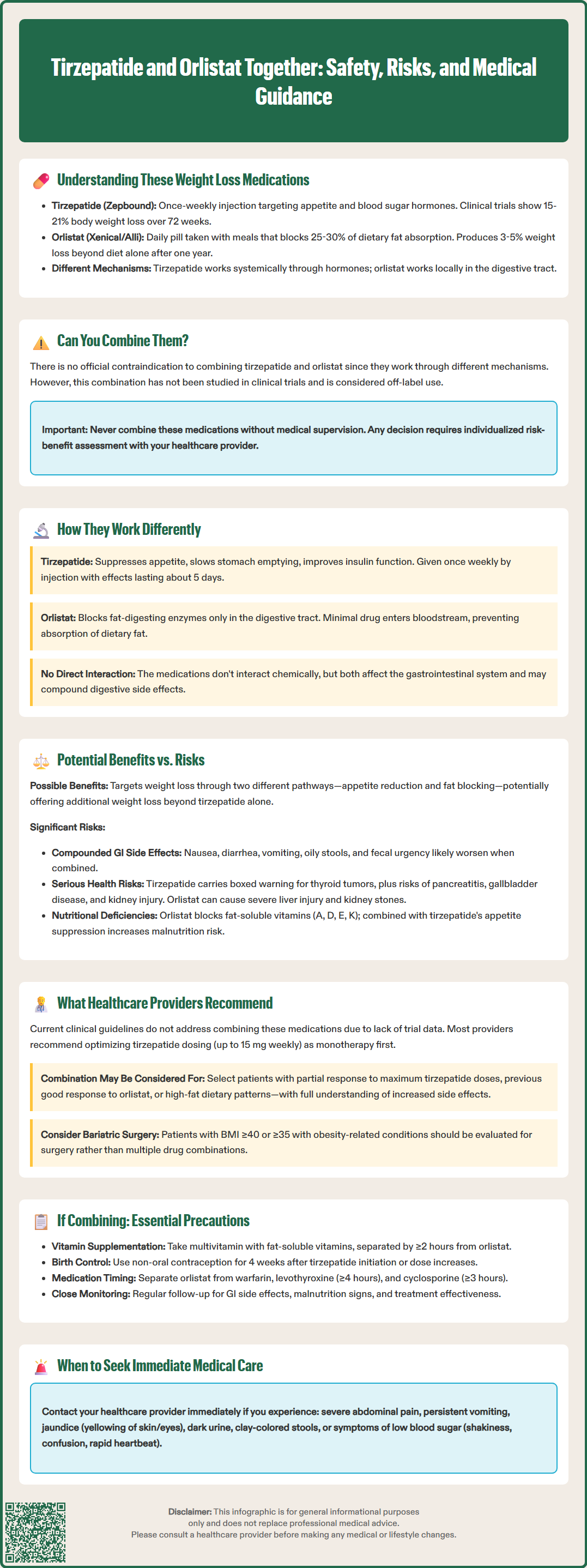LOSE WEIGHT WITH MEDICAL SUPPORT — BUILT FOR MEN
- Your personalised programme is built around medical care, not willpower.
- No generic diets. No guesswork.
- Just science-backed results and expert support.
Find out if you’re eligible

Combining tirzepatide and orlistat together represents an off-label approach to weight management that some patients and providers may consider. While these medications work through entirely different mechanisms—tirzepatide as a dual GIP/GLP-1 receptor agonist reducing appetite and orlistat as a lipase inhibitor blocking fat absorption—there is no clinical trial data specifically evaluating their combined use. The FDA-approved Zepbound prescribing information explicitly states that tirzepatide has not been studied with other weight loss products. Understanding the potential benefits, significant risks, and lack of evidence is essential before considering this combination under close medical supervision.
Quick Answer: Tirzepatide and orlistat can be taken together as there is no official contraindication, but this combination is off-label, unstudied in clinical trials, and may significantly increase gastrointestinal side effects.
Tirzepatide and orlistat represent two fundamentally different approaches to weight management, each approved by the FDA for specific indications. Tirzepatide (marketed as Mounjaro for type 2 diabetes and Zepbound for chronic weight management) is a dual glucose-dependent insulinotropic polypeptide (GIP) and glucagon-like peptide-1 (GLP-1) receptor agonist administered as a once-weekly subcutaneous injection. Zepbound was approved for weight management in adults with obesity (BMI ≥30 kg/m²) or overweight (BMI ≥27 kg/m²) with at least one weight-related comorbidity in November 2023. Importantly, Mounjaro is FDA-approved only for type 2 diabetes, not for weight management.
Orlistat is available as prescription Xenical 120 mg (for adults with BMI ≥30 kg/m² or ≥27 kg/m² with comorbidities) or over-the-counter Alli 60 mg (for overweight adults, typically BMI ≥25 kg/m², following a reduced-calorie, low-fat diet). Orlistat has been available since 1999 and works through an entirely different mechanism as a gastrointestinal lipase inhibitor taken orally three times daily with meals containing fat.
Both medications have demonstrated efficacy in clinical trials, though their mechanisms, administration routes, side effect profiles, and patient selection criteria differ substantially. In the SURMOUNT-1 trial, tirzepatide showed significant weight loss results in adults without diabetes over 72 weeks (15-21% body weight reduction, depending on dose), while orlistat typically produces more modest results (approximately 3-5% additional weight loss beyond placebo at 1 year). Understanding these differences is essential when considering whether combination therapy might offer additional benefits for patients struggling with obesity and its associated health complications.
There is currently no official contraindication to taking tirzepatide and orlistat together, as they work through completely different mechanisms and are not known to have direct pharmacological interactions. However, it's important to note that this combination is considered off-label use, and the Zepbound prescribing information specifically states it has not been studied with other weight loss products.
The absence of a contraindication does not mean combination therapy is routinely recommended or well-studied. Clinical trial data specifically examining the safety and efficacy of tirzepatide and orlistat used together is extremely limited or nonexistent. Most major clinical trials for tirzepatide excluded patients taking other weight loss medications, making it difficult to assess the true benefit-to-risk ratio of combination therapy.
From a practical standpoint, healthcare providers may consider this combination in select cases through individualized risk-benefit assessment, but several important factors warrant careful consideration:
Overlapping gastrointestinal side effects may significantly impact tolerability
Cost considerations, as both medications can be expensive
Lack of evidence demonstrating additive benefits
Monitoring requirements for both medications
Drug interactions with other medications (orlistat may interact with warfarin, requiring INR monitoring; cyclosporine, requiring separation by ≥3 hours; and levothyroxine, requiring separation by ≥4 hours)
Any decision to combine these medications should be made collaboratively between patient and prescriber, with careful consideration of individual circumstances, treatment goals, previous responses to monotherapy, and the patient's ability to tolerate potential side effects. Self-initiated combination therapy without medical supervision is not advisable given the complexity of managing potential adverse effects and the need for appropriate clinical monitoring.

Understanding the distinct mechanisms of action helps explain why these medications might theoretically be combined, though it also highlights potential tolerability concerns.
Tirzepatide's Mechanism of Action: Tirzepatide functions as a dual agonist, activating both GIP and GLP-1 receptors. This dual action produces multiple metabolic effects:
Appetite suppression through central nervous system pathways affecting satiety centers
Delayed gastric emptying, which prolongs feelings of fullness
Enhanced insulin secretion in a glucose-dependent manner
Reduced glucagon secretion, decreasing hepatic glucose production
Weight loss-associated improvements in insulin sensitivity in peripheral tissues
These effects occur systemically after subcutaneous absorption, with median peak concentrations reached in approximately 48-72 hours and a half-life of about 5 days allowing once-weekly dosing. Importantly, tirzepatide's delay of gastric emptying can reduce the absorption of oral medications, including oral contraceptives, particularly during initiation and dose escalation periods.
Orlistat's Mechanism of Action: Orlistat works exclusively in the gastrointestinal tract through a completely different mechanism:
Inhibits pancreatic and gastric lipases, enzymes that break down dietary triglycerides
Prevents approximately 25-30% of dietary fat absorption from the intestinal lumen
Remains largely unabsorbed systemically (less than 1% enters circulation)
Excreted primarily in feces, carrying unabsorbed fat with it
Because orlistat acts locally in the gut rather than systemically, and tirzepatide works through hormonal pathways, there is no direct pharmacological interaction. However, both medications affect the gastrointestinal system—tirzepatide by slowing motility and orlistat by preventing fat absorption—which may compound digestive side effects when used together.
The theoretical rationale for combining tirzepatide and orlistat centers on their complementary mechanisms, but this must be weighed against practical considerations and potential risks.
Potential Benefits: The primary theoretical advantage is additive weight loss through different pathways—tirzepatide reducing appetite and caloric intake while orlistat blocks absorption of consumed dietary fat. Some patients who achieve partial response to one medication might hypothetically benefit from adding the other. Additionally, patients with specific dietary patterns high in fat might theoretically benefit from orlistat's fat-blocking mechanism alongside tirzepatide's appetite effects.
Significant Risks and Concerns:
Gastrointestinal side effects represent the most substantial concern. According to the Zepbound prescribing information, tirzepatide commonly causes nausea (24-29%), diarrhea (18-24%), vomiting (8-11%), constipation (16-17%), and abdominal pain (10-15%), with rates increasing at higher doses. Orlistat predictably causes oily spotting, flatulence with discharge, fecal urgency, fatty/oily stools, and increased defecation. Combining these medications could result in severe gastrointestinal distress that significantly impairs quality of life and medication adherence.
Serious safety concerns for tirzepatide include:
Boxed warning for thyroid C-cell tumors (contraindicated in patients with personal/family history of MTC or MEN2)
Risk of pancreatitis
Gallbladder disease
Acute kidney injury from dehydration
Hypoglycemia (when used with insulin or sulfonylureas)
Serious safety concerns for orlistat include:
Rare cases of severe liver injury
Risk of oxalate nephropathy and kidney stones
Nutritional considerations also warrant attention. Orlistat reduces absorption of fat-soluble vitamins (A, D, E, K), requiring supplementation taken at least 2 hours apart from orlistat (ideally at bedtime). Tirzepatide's effects on gastric emptying and appetite may already reduce nutritional intake, potentially compounding deficiency risks.
Red-flag symptoms requiring immediate medical attention include severe abdominal pain, persistent vomiting, jaundice, dark urine, clay-colored stools, or signs of hypoglycemia.
Cost-effectiveness is questionable, as both medications are expensive, and insurance coverage for combination weight loss therapy is often limited.
Current clinical guidelines from major organizations including the American Diabetes Association (ADA) and the American Gastroenterological Association (AGA) do not specifically address combining tirzepatide with orlistat, reflecting the absence of robust clinical trial data for this combination.
General Clinical Approach: Most healthcare providers follow a stepwise approach to weight management pharmacotherapy:
Monotherapy first: Optimize a single agent before considering combination therapy
Lifestyle foundation: Ensure dietary modification and physical activity are maximized
Adequate trial duration: Allow 3-6 months to assess full response to initial therapy
Continuation criteria: Per guidelines, patients should achieve ≥5% weight loss after 12 weeks on a therapeutic dose to continue medication
Reassess goals: Determine if additional intervention is truly necessary
Given tirzepatide's superior efficacy compared to older weight loss medications, providers typically recommend optimizing tirzepatide dosing (up to 15 mg weekly for Zepbound) before adding other agents. If a patient has achieved substantial weight loss on tirzepatide but has plateaued, providers might consider whether the modest additional benefit from orlistat justifies the added side effects and cost.
When Combination Might Be Considered: In select cases, clinicians might discuss combination therapy for patients who:
Have achieved partial but insufficient response to maximally tolerated tirzepatide
Have specific dietary patterns with high fat intake
Have previously responded well to orlistat but need additional intervention
Understand and accept the increased side effect burden
For patients with BMI ≥40 kg/m² or ≥35 kg/m² with obesity-related comorbidities, referral for bariatric surgery evaluation should be considered per American Society for Metabolic and Bariatric Surgery guidelines, rather than pursuing multiple pharmacotherapies.
Essential Monitoring and Patient Counseling: If combination therapy is pursued, providers should ensure:
Close monitoring for gastrointestinal tolerability
Vitamin supplementation (multivitamin with fat-soluble vitamins taken ≥2 hours from orlistat)
Clear instructions on timing (orlistat with fat-containing meals, skip if meal is skipped or fat-free; tirzepatide weekly)
Contraception counseling: Use non-oral or backup contraception for 4 weeks after tirzepatide initiation and after each dose increase
Medication interaction management: Monitor INR if on warfarin; separate cyclosporine by ≥3 hours and levothyroxine by ≥4 hours from orlistat
Defined endpoints for assessing whether combination provides meaningful benefit
Safety parameters including triggers for discontinuation
Patients should be counseled to report severe or persistent gastrointestinal symptoms, signs of malnutrition, jaundice, dark urine, or severe abdominal pain. The decision to combine these medications should never be made without medical supervision, and patients should not initiate orlistat (even the over-the-counter formulation) while taking tirzepatide without discussing it with their healthcare provider.
There is no official contraindication to taking tirzepatide and orlistat together, but this combination is off-label and has not been studied in clinical trials. Both medications commonly cause gastrointestinal side effects that may be significantly worse when combined, requiring close medical supervision.
Tirzepatide and orlistat do not have direct pharmacological interactions because they work through completely different mechanisms—tirzepatide systemically through hormone receptors and orlistat locally in the gastrointestinal tract. However, both affect the digestive system and may compound side effects like nausea, diarrhea, and abdominal discomfort.
Healthcare providers typically recommend optimizing tirzepatide dosing (up to 15 mg weekly for Zepbound) before adding other weight loss medications. Any decision to combine tirzepatide with orlistat should be made with your provider after careful assessment of potential benefits versus increased side effects and costs.
All medical content on this blog is created using reputable, evidence-based sources and is regularly reviewed for accuracy and relevance. While we strive to keep our content current with the latest research and clinical guidelines, it is intended for general informational purposes only.
This content is not a substitute for professional medical advice, diagnosis, or treatment. Always consult a licensed healthcare provider with any medical questions or concerns. Use of this information is at your own risk, and we are not liable for any outcomes resulting from its use.